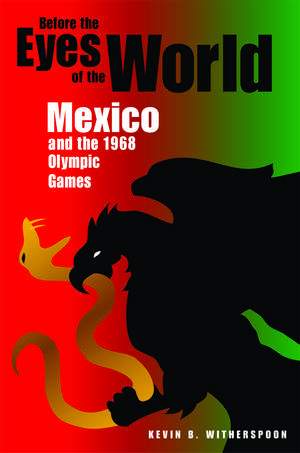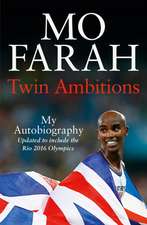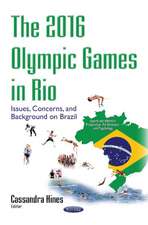Before the Eyes of the World: Mexico and the 1968 Olympic Games
Autor Kevin B. Witherspoonen Limba Engleză Hardback – 30 iun 2008
Mexican leaders eagerly anticipated the attention that hosting the world’s most visible sporting event would bring, yet they could not have predicted the array of conflicts that would play out before the eyes of the world during the notorious 1968 Mexico City Olympics. Following 20 years of economic growth and political stability—known as the “Mexican miracle”—Mexican policy makers escaped their prior image of being economically underdeveloped to successfully craft an image of a nation that was both modern and cosmopolitan but also steeped in culture and tradition. Buoyed by this new image, they set their sights on the Olympic bid, and they not only won but also prepared impressive facilities.
Prior to the opening ceremonies, several controversies emerged, the most glaring of which was a student protest movement that culminated in a public massacre, leaving several hundred students dead. Less dramatic were concerns that athletes would suffer harm in the high elevation and thin air, debates over the nature of amateurism, threats by nations opposing apartheid to boycott if South Africa was allowed to compete, and the introduction of drug and gender testing. Additionally the Olympics provided a forum for the United States and the Soviet Union to carry their Cold War rivalry to the playing field—a way to achieve victory without world destruction at stake.
During the Games, one of the most significant controversies occurred when two African American athletes, Tommie Smith and John Carlos, raised their fists in the Black Power salute while on the medal stand. This gesture brought worldwide attention to racism within the United States and remains a lasting image of both the Mexico City Olympics and the Civil Rights movement. Although the Olympics are intended to bring athletes of the world together for harmonious competition, the 1968 Games will long be remembered as fraught with discord. This ambitious and comprehensive study will appeal to those interested in U.S. history, Latin American history, sports history, and Olympic history.
Prior to the opening ceremonies, several controversies emerged, the most glaring of which was a student protest movement that culminated in a public massacre, leaving several hundred students dead. Less dramatic were concerns that athletes would suffer harm in the high elevation and thin air, debates over the nature of amateurism, threats by nations opposing apartheid to boycott if South Africa was allowed to compete, and the introduction of drug and gender testing. Additionally the Olympics provided a forum for the United States and the Soviet Union to carry their Cold War rivalry to the playing field—a way to achieve victory without world destruction at stake.
During the Games, one of the most significant controversies occurred when two African American athletes, Tommie Smith and John Carlos, raised their fists in the Black Power salute while on the medal stand. This gesture brought worldwide attention to racism within the United States and remains a lasting image of both the Mexico City Olympics and the Civil Rights movement. Although the Olympics are intended to bring athletes of the world together for harmonious competition, the 1968 Games will long be remembered as fraught with discord. This ambitious and comprehensive study will appeal to those interested in U.S. history, Latin American history, sports history, and Olympic history.
| Toate formatele și edițiile | Preț | Express |
|---|---|---|
| Paperback (1) | 132.81 lei 3-5 săpt. | |
| Northern Illinois University Press – 13 ian 2014 | 132.81 lei 3-5 săpt. | |
| Hardback (1) | 201.73 lei 3-5 săpt. | |
| Northern Illinois University Press – 30 iun 2008 | 201.73 lei 3-5 săpt. |
Preț: 201.73 lei
Nou
Puncte Express: 303
Preț estimativ în valută:
38.60€ • 42.06$ • 32.53£
38.60€ • 42.06$ • 32.53£
Carte disponibilă
Livrare economică 03-17 aprilie
Preluare comenzi: 021 569.72.76
Specificații
ISBN-13: 9780875803883
ISBN-10: 0875803881
Pagini: 224
Dimensiuni: 152 x 229 x 23 mm
Greutate: 0.51 kg
Ediția:1
Editura: Northern Illinois University Press
Colecția Northern Illinois University Press
ISBN-10: 0875803881
Pagini: 224
Dimensiuni: 152 x 229 x 23 mm
Greutate: 0.51 kg
Ediția:1
Editura: Northern Illinois University Press
Colecția Northern Illinois University Press
Recenzii
“This is one of the best books I have read on Olympic sports. No one has discussed the 1968 games as thoroughly and as thoughtfully as Witherspoon.”—Allen Guttmann, Amherst College
“Witherspoon does a commendable job at delivering a cogently organized, very raedable narrative of the history of sporting events in Mexico, culminating in the 1968 Games. The book's broader discussion of the politics of international Olympic sporting is both engaging and revealing.”—The Americas
"Witherspoon's organization of the material is tight, his exposition rich, at times riveting, and always lucid. Before the Eyes of the World is the best book I have ever read treating one specific Olympic Games.—Olympika
“Witherspoon does a commendable job at delivering a cogently organized, very raedable narrative of the history of sporting events in Mexico, culminating in the 1968 Games. The book's broader discussion of the politics of international Olympic sporting is both engaging and revealing.”—The Americas
"Witherspoon's organization of the material is tight, his exposition rich, at times riveting, and always lucid. Before the Eyes of the World is the best book I have ever read treating one specific Olympic Games.—Olympika
Notă biografică
Kevin B. Witherspoon is Assistant Professor of History at Lander University in South Carolina.
Cuprins
Table of Contents
Preface
Introduction
Chapter 1: How the Olympics Came to Mexico
Chapter 2: Image Preserved: Early Controversies and the Cultural Olympics
Chapter 3: Image Tarnished: The Revolt of the Black Athlete
Chapter 4: Image Shattered: Tlatelolco
Chapter 5: The World Watches: October ‘68
Chapter 6: Settling the Score
Notes
Bibliography
Index
Introduction
Chapter 1: How the Olympics Came to Mexico
Chapter 2: Image Preserved: Early Controversies and the Cultural Olympics
Chapter 3: Image Tarnished: The Revolt of the Black Athlete
Chapter 4: Image Shattered: Tlatelolco
Chapter 5: The World Watches: October ‘68
Chapter 6: Settling the Score
Notes
Bibliography
Index
Descriere
Mexican leaders eagerly anticipated the attention that hosting the world’s most visible sporting event would bring, yet they could not have predicted the array of conflicts that would play out before the eyes of the world during the notorious 1968 Mexico City Olympics. Following 20 years of economic growth and political stability—known as the “Mexican miracle”—Mexican policy makers escaped their prior image of being economically underdeveloped to successfully craft an image of a nation that was both modern and cosmopolitan but also steeped in culture and tradition. Buoyed by this new image, they set their sights on the Olympic bid, and they not only won but also prepared impressive facilities.
Prior to the opening ceremonies, several controversies emerged, the most glaring of which was a student protest movement that culminated in a public massacre, leaving several hundred students dead. Less dramatic were concerns that athletes would suffer harm in the high elevation and thin air, debates over the nature of amateurism, threats by nations opposing apartheid to boycott if South Africa was allowed to compete, and the introduction of drug and gender testing. Additionally the Olympics provided a forum for the United States and the Soviet Union to carry their Cold War rivalry to the playing field—a way to achieve victory without world destruction at stake.
During the Games, one of the most significant controversies occurred when two African American athletes, Tommie Smith and John Carlos, raised their fists in the Black Power salute while on the medal stand. This gesture brought worldwide attention to racism within the United States and remains a lasting image of both the Mexico City Olympics and the Civil Rights movement. Although the Olympics are intended to bring athletes of the world together for harmonious competition, the 1968 Games will long be remembered as fraught with discord. This ambitious and comprehensive study will appeal to those interested in U.S. history, Latin American history, sports history, and Olympic history.
Prior to the opening ceremonies, several controversies emerged, the most glaring of which was a student protest movement that culminated in a public massacre, leaving several hundred students dead. Less dramatic were concerns that athletes would suffer harm in the high elevation and thin air, debates over the nature of amateurism, threats by nations opposing apartheid to boycott if South Africa was allowed to compete, and the introduction of drug and gender testing. Additionally the Olympics provided a forum for the United States and the Soviet Union to carry their Cold War rivalry to the playing field—a way to achieve victory without world destruction at stake.
During the Games, one of the most significant controversies occurred when two African American athletes, Tommie Smith and John Carlos, raised their fists in the Black Power salute while on the medal stand. This gesture brought worldwide attention to racism within the United States and remains a lasting image of both the Mexico City Olympics and the Civil Rights movement. Although the Olympics are intended to bring athletes of the world together for harmonious competition, the 1968 Games will long be remembered as fraught with discord. This ambitious and comprehensive study will appeal to those interested in U.S. history, Latin American history, sports history, and Olympic history.







